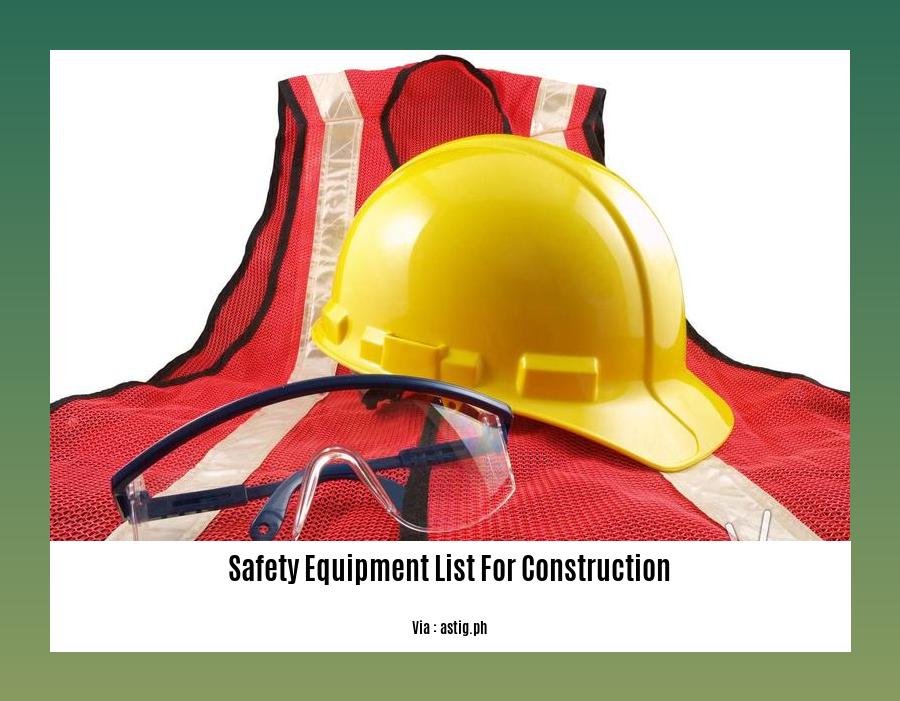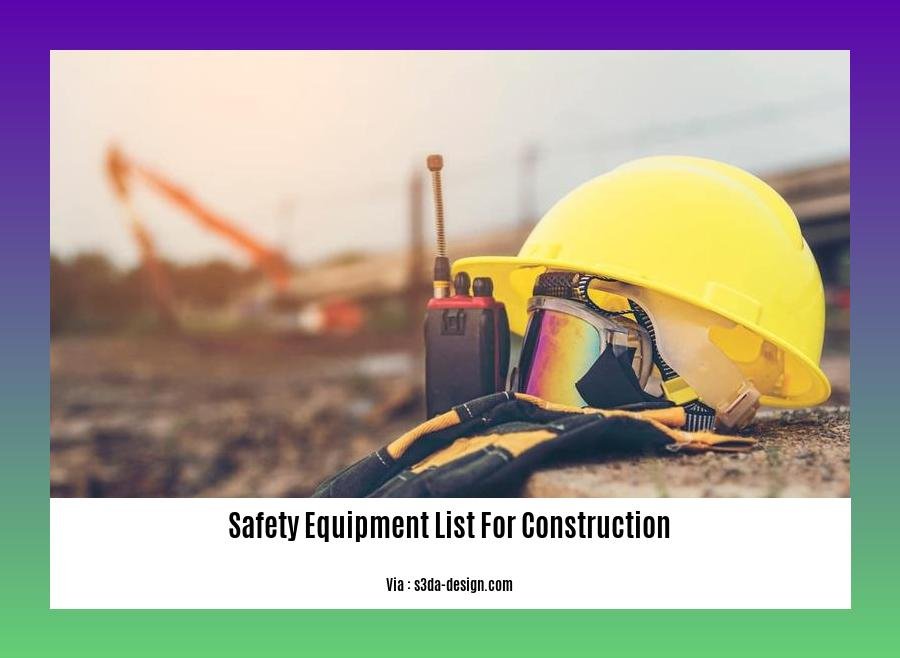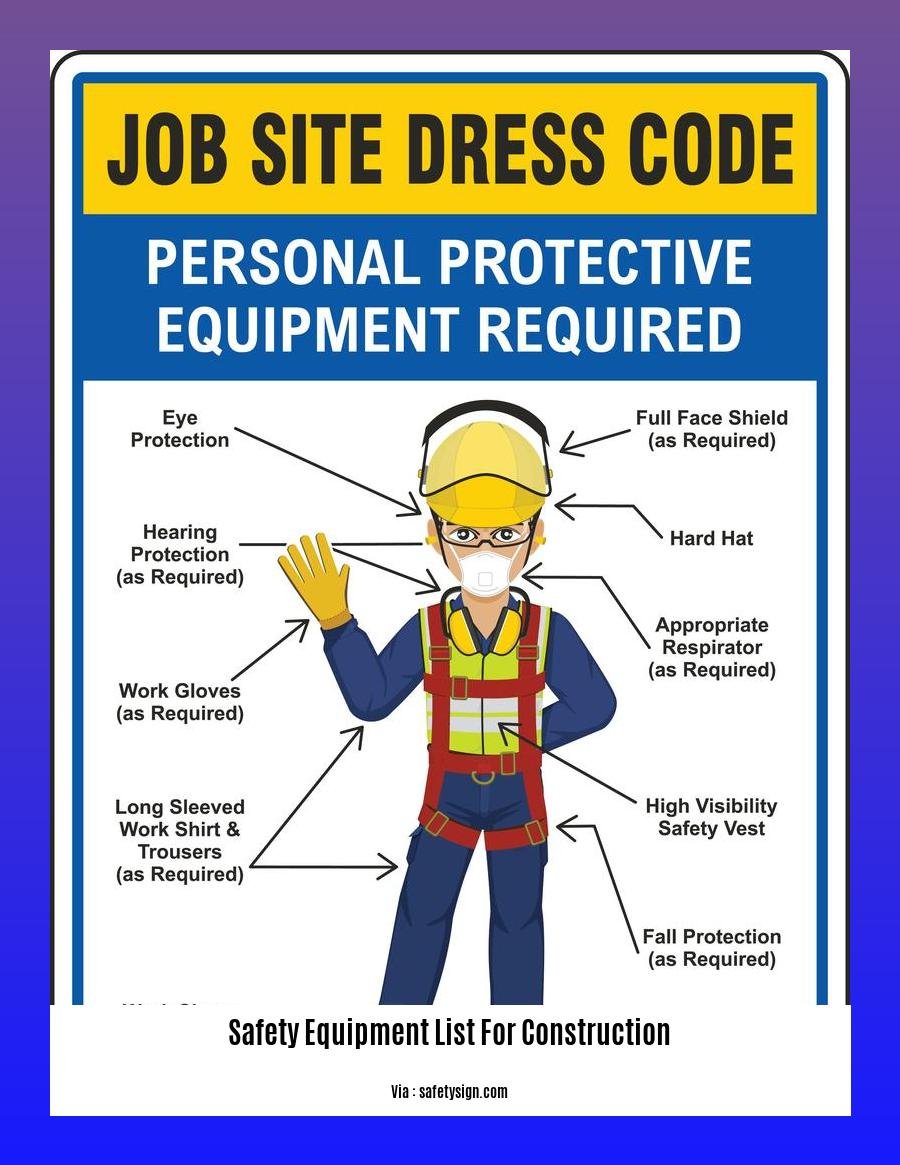Safety Equipment List for Construction: Essential Gear for Safe Work Sites
When it comes to construction, safety should always be the top priority. Having the right safety equipment in place is crucial for preventing accidents and injuries on construction sites. This comprehensive list of essential safety equipment will help you create a safe work environment and ensure the well-being of your crew.
Key Takeaways:
-
Essential Safety Equipment for Construction:
- Hard hat
- Safety glasses/goggles
- Ear protection
- Safety gloves
- Safety boots
- Reflective clothing
-
Additional Safety Equipment:
- Respirators
- Safety harnesses
- High-vis vests
- First aid
- Safety signs
Safety Equipment List for Construction

Safety is paramount on any construction site. As an experienced construction safety professional, I’ve compiled a comprehensive list of essential safety equipment that every worksite should have in place to protect workers:
Head Protection:
- Hard Hats: Protect against falling objects and head injuries. Choose hard hats that meet ANSI Z89.1 standards.
Eye and Face Protection:
- Safety Glasses or Goggles: Shield eyes from flying debris, chemicals, and UV radiation. Look for ANSI Z87.1-rated gear.
Hearing Protection:
- Ear Protection: Protect ears from excessive noise levels. Choose earplugs or earmuffs that meet NIOSH or ANSI standards.
Hand Protection:
- Safety Gloves: Protect hands from cuts, abrasions, chemicals, and sharp objects. Select gloves based on the specific hazards present.
Foot Protection:
- Safety Boots: Prevent foot injuries from falling objects, slips, and electrical hazards. Choose boots that meet ASTM F2413 standards.
Body Protection:
- Reflective Clothing: Enhances visibility and reduces the risk of being struck by moving vehicles or equipment.
Additional Essential Items:
- Respirators: Protect against airborne contaminants like dust, fumes, and gases.
- Safety Harnesses: Prevent falls when working at heights.
- First Aid Essentials: Treat minor injuries and emergencies on-site.
- Safety Nets: Catch falling workers or debris, reducing the risk of serious injuries or fatalities.
Understanding the responsibilities of a safety officer on a construction site is paramount for ensuring worker well-being. Explore the comprehensive guide to learn more about their crucial role at responsibility of safety officer in construction site.
To ensure a safe and compliant construction site, establishing a safety board is essential. Discover the importance and best practices of safety boards at safety board for construction site.
Addressing safety concerns in construction is vital for mitigating risks. Delve into the common challenges and effective strategies for ensuring worker safety at safety concerns in construction.
Equipping construction workers with adequate safety gear is non-negotiable. Explore the essential personal protective equipment (PPE) and guidelines for ensuring worker protection at safety gear construction workers.
High-visibility clothing
When it comes to personal safety equipment on a construction site, assuring the visibility of the workers is paramount. This is where high-visibility clothing plays a crucial role.
High-visibility clothing is designed to enhance the visibility of construction workers, especially in low-light conditions. It’s typically made from bright, reflective materials that contrast with the background, making the wearer easily noticeable to drivers and other vehicle operators.
Why is it important?
Construction sites are often busy environments with heavy machinery and moving vehicles. High-visibility clothing helps to prevent accidents by increasing the visibility of workers in these hazardous conditions. It reduces the risk of collisions and ensures that workers can be seen in emergency situations.
Key Takeaways:
- High-visibility clothing is essential safety gear for construction sites, as it enhances the visibility of workers in low-light conditions.
- It’s made from bright, reflective materials that contrast with the background, making the wearer easily noticeable.
- This clothing helps prevent accidents by reducing the risk of collisions with vehicles and equipment.
- ANSI/ISEA 107-2020 is the American National Standard for High-Visibility Safety Apparel and specifies performance requirements for this type of clothing.
Relevant URL Sources:
- High-Visibility Safety Apparel
- ANSI/ISEA 107-2020: High-Visibility Safety Apparel
Work boots: Your Trusted Ally for Safety on Construction Sites

Work boots are the backbone of protection for construction workers. These sturdy companions play a crucial role in preventing injuries and keeping feet safe amidst the hazards that construction sites pose. With their robust construction and specialized features, let’s dive into why work boots are an indispensable part of a construction worker’s safety gear.
Key Types of Work boots
1. Electrical Hazard (EH) Boots
– Shield against electrical shock and burns from accidental contact with energized circuits or equipment.
2. Slip-Resistant Boots
– Provide exceptional traction on slippery surfaces like wet concrete, oily floors, and uneven terrain.
3. Penetration-Resistant Boots
– Protect against punctures from sharp objects like nails, screws, or debris.
4. High-Cut Boots
– Offer added ankle support, guarding against sprains and fractures from falling objects or uneven surfaces.
5. Waterproof Boots
– Keep feet dry and comfortable in wet conditions, such as working in rain or standing in puddles.
Choosing the Right Work boots
Selecting the appropriate work boots is essential. Consider the specific hazards present on your job site and choose boots designed to address those risks.
Benefits of Wearing the Right Work boots
- Enhanced protection against workplace injuries
- Reduced risk of slips, falls, and punctures
- Improved comfort and support for extended work hours
- Increased productivity due to reduced discomfort and accidents
- Compliance with industry safety regulations
Pro Tips:
- Replace worn-out work boots promptly to ensure optimal protection.
- Keep work boots clean and maintained to extend their lifespan.
- Train workers on the importance of wearing proper work boots and how to choose the right ones.
Key Takeaways:
- Work boots are essential for protecting construction workers from on-site hazards.
- Choose work boots based on the specific risks present on your job site.
- Regular maintenance and replacement of work boots ensure optimal protection.
- Wearing the right work boots contributes to safety, comfort, and productivity on construction sites.
Relevant URL Sources:
- Importance of Safety Boots in Construction | Safeopedia
- Types of Safety Boots for Construction Sites | ConEquipParts
Gloves: Essential Protection for Construction Workers
Protecting your hands on a construction site is paramount to prevent cuts, abrasions, and chemical burns. Gloves serve as a vital barrier between your skin and potential hazards.
Key Takeaways:
- Choose gloves based on the specific hazards present on the construction site.
- Consider specialist gloves for tasks like concrete work or carpentry.
- Select hardwearing or heavy-duty gloves with cut protection.
- Natural latex rubber is ideal for electricians’ safety gloves.
- Wear non-conductive gloves for electrical safety.
Types of Construction Gloves
Construction gloves come in various types, each tailored to different tasks.
- General-purpose gloves: Provide basic protection from dirt, dust, and debris.
- Concrete gloves: Thick and durable, designed for handling rough surfaces and concrete.
- Carpentry gloves: Offer dexterity and grip while protecting against splinters and nails.
- Chemical-resistant gloves: Protect against contact with hazardous chemicals.
- Electrician’s gloves: Insulated to provide electrical shock protection.
Choosing the Right Gloves
Selecting the right gloves depends on the hazards at hand. Consider these factors:
- Type of materials being handled
- Level of abrasion or cut resistance required
- Chemical exposure risks
- Moisture or weather conditions
- Grip and dexterity needed
Tips for Proper Glove Use
- Inspect gloves before each use for damage or tears.
- Wear gloves that fit properly to ensure dexterity and comfort.
- Replace gloves frequently, especially if they show signs of wear or damage.
- Clean gloves regularly to prevent bacteria buildup.
- Store gloves in a dry and well-ventilated area.
By choosing the right gloves and using them properly, you can significantly reduce the risk of hand injuries on construction sites.
Citations:
FAQ
Q1: What is the most important piece of PPE for construction workers?
A1: Hard hats are the most important piece of PPE for construction workers as they protect their heads from falling objects and other hazards.
Q2: What type of clothing is best for construction workers?
A2: Safety clothing made from flame-resistant fabric and high-visibility clothing are best for construction workers as they provide protection from hazards and improve visibility.
Q3: What are the different types of safety boots available for construction sites?
A3: Different types of safety boots available for construction sites include electrical hazard shoes, slip-resistant boots, penetration-resistant footwear, high cut safety boots, and PVC boots & gumboots.
Q4: What are the different types of construction gloves available?
A4: Different types of construction gloves available include general-purpose gloves, specialist gloves like concrete or carpentry gloves, and non-conductive gloves for electrical safety.
Q5: What are the additional PPE items that construction sites should have in place?
A5: Additional PPE items that construction sites should have in place include respirators, safety harnesses, high-visibility vests, first aid essentials, and safety nets.
- Does 100% Polyester Shrink? A Complete Guide to Washing & Drying - April 16, 2025
- Elegant Drapery Solutions for Arched Windows: A Complete Guide - April 16, 2025
- The Best Dining Room Tables with Drop Leaves: A Buyer’s Guide - April 16, 2025










